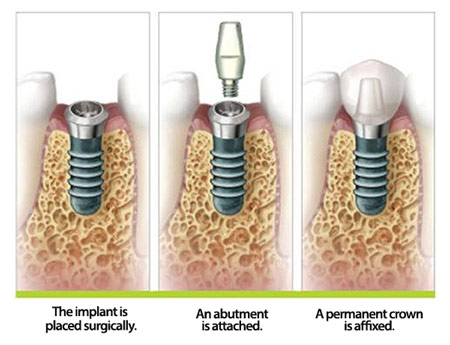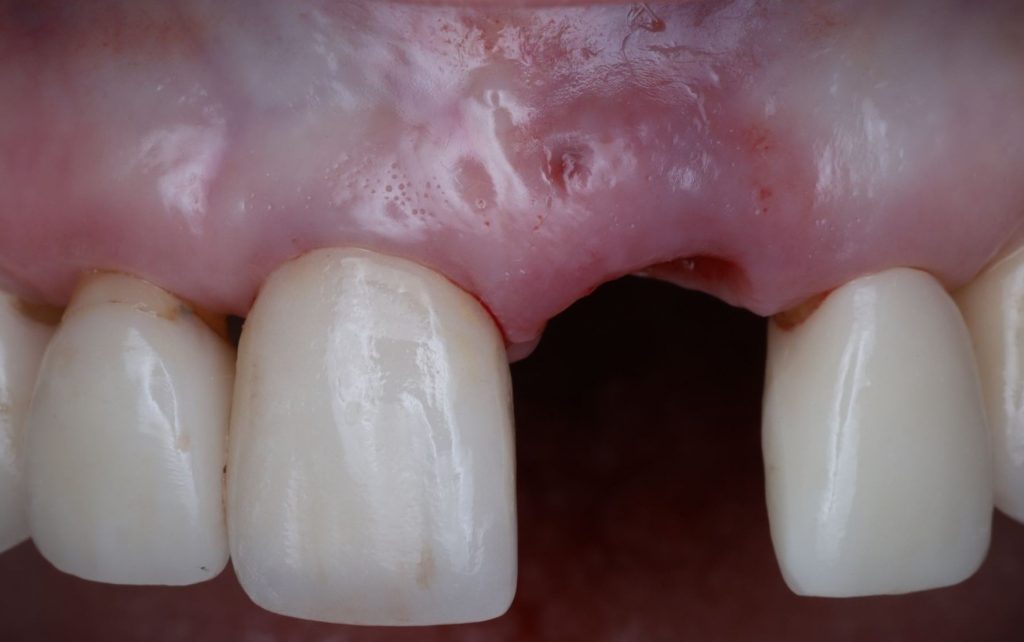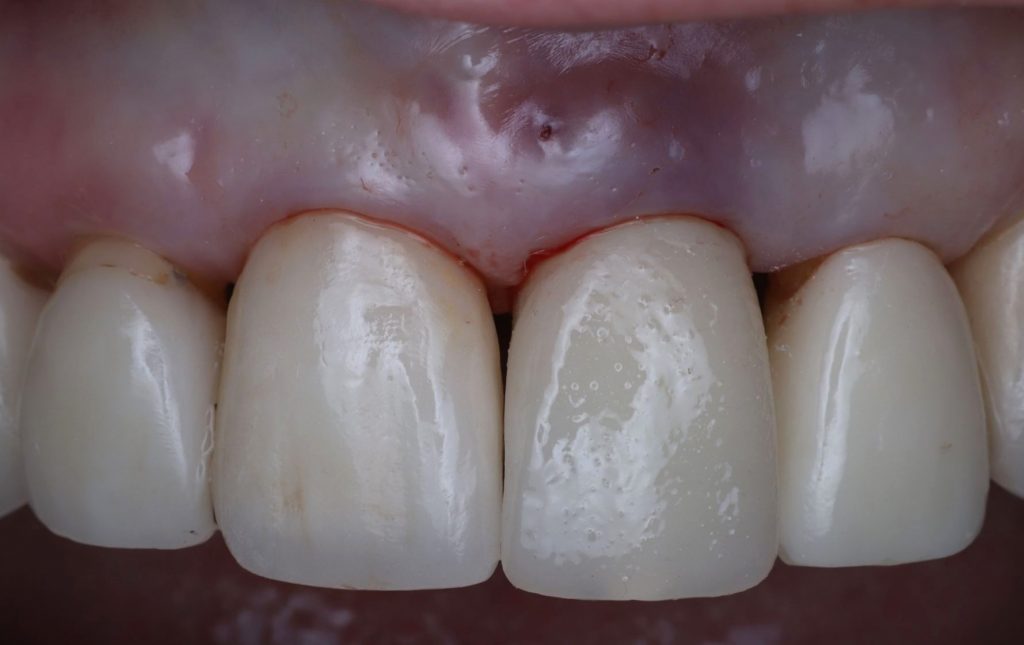Dental Implants
A dental implant is a titanium or zirconia screw, designed to aid in restoration and replacement of missing teeth.
Table of Contents
What are dental implants?
Dental implants have quickly become one of the most important and innovations in dentistry. A dental implant is a screw, usually made of titanium, that is placed into the jaw bone. Its unique material and surface properties allow it to fuse, or osseointegrate, with the bone. Once the implant and the bone are integrated, then it can be used for restorations with intermediate abutments. They can be used for replacing a single tooth all the way to an entire arch/jaw of teeth. For single tooth replacements, the implant acts as the “root” of the artificial tooth, and a crown is connected to the implant. For multiple teeth replacements, implants can act as anchors for a connected bridge, and for full-arch or full-mouth rehabilitation, multiple implants can be connected for either a single-span full-arch prosthesis, or multiple segmented bridge restorations.
There are hundreds of implant company and manufacturers, but they are not all created equally. In order to provide the highest quality and most predictable care, we only use two of the best implant systems: Nobel Biocare and Straumann. They are the original companies to develop the dental implants we use today and are the world-wide leaders and innovators in dental implants. As the two most respected implant brands in the world, they offer a lifetime guarantee/warranty for their dental implants.
Dental implants are placed and fused with the jaw bone. In cases where teeth have been missing for a long time, the bone may shrink or atrophy and additional bone grafting may be needed to support dental implants. We will always do our best to minimize the number of procedures and healing time you need while providing predictable, high-quality care.
What you should know before your Dental Implant in Orange County
Before scheduling for a dental implant procedure, you will first need to have a consultation. First and foremost, we need to ensure the surrounding gums and bone are healthy so that the implants have the best chance for long-term success and minimize the chance for peri-implant disease. We will discuss what the final restorative goal is, so that we can ensure we have successful outcomes. Dental implants require meticulously planning, with many goals in mind including the final restorative goal as well as your anatomy. In order to properly plan the implant, a 3D or CBCT scan (cone beam computed tomography) is needed to evaluate the available bone, location of the sinus cavity, nerves, etc. We can take the scan at your consultation appointment, or if you have a recent scan, you may bring us a copy for us to interpret. We will go over the scan and results of the examination and whether you are a good candidate for dental implants, or if additional procedures will be needed to support the dental implant. For certain cases that may require a surgical guide or temporary to be fabricated, a digital intraoral scan may be performed to obtain an impression of your teeth (compared to the old method of goopy alginate impressions).
When we plan the dental implant procedure, we strive to minimize the number of appointments and procedures needed – meaning if a tooth needs to be extracted, we will try to plan on placing the implant and performing the bone grafting at the same appointment to minimize the overall healing/recovery period.

What happens during your dental implant procedure?
Before we start the procedure, we will often give a single loading dose of antibiotics and anti-inflammatory medications, as studies show it can help with implant success.
What kind of anesthesia is used?
Most of the time, we do dental implant procedures under local anesthesia. The area is numbed just like any other dental procedure. We also offer two additional sedative options. An oral sedative or anxiolytic can be prescribed for you to take an hour before the procedure, which will help calm you down and make you drowsy during the procedure. You may or may not remember the procedure afterward. Another sedation option we offer is “twilight” anesthesia. A board-certified dental anesthesiologist will administer medication through an IV line to make sure you are safely sedated and asleep during the entire procedure.
The surgical procedure
During the procedure, the area that we will be working on will be numbed with a local anesthetic. If the tooth is still present, then the tooth will be removed as carefully and atraumatically as possible. If the tooth is already missing, an incision will be made and the gums reflected away from the bone. Sequential osteotomies (drilling) into the bone is made with progressively wider drills until the site is prepared. Dental radiographs/x-rays may be taking to verify the position and depth of the drills. The dental implant is placed into the bone at a low speed to the correct depth and position. Depending on the initial stability and the overall plan, either a cover screw will be placed on the implant for submerged healing, or a healing (temporary) abutment will be attached to the implant to allow the gums to heal around the implant. This healing abutment will be removed and replaced throughout the final restorative stages of the implant process. Additional procedures like sinus lift, bone grafting, or soft tissue grafting may be performed at the time of the dental implant placement. The gums will be sutured together with dissolvable stitches.
How long is the dental implant procedure appointment?
The dental implant placement procedure is usually a simple and straightforward procedure. The appointment is usually around 1.5 hours for a single implant, but actual procedure is only around 30 minutes. Depending on how complex the case is, such as multiple implants being placed or bone grafting, then the appointment may be longer in duration.
Dental Implant recovery and results: what to expect
After the surgical procedure, you will have dissolvable stitches in the area. Depending exactly what stitches are used, they may fall off in around a week or we will remove them at your post-operative appointment. After the local anesthesia wears off, you may be sore or experience some aching in the surgical area. Any discomfort can usually be resolved with ibuprofen (Advil) or acetaminophen (Tylenol). Stronger pain medications are rarely needed but can be prescribed depending on your pain sensitivity.
During the first two weeks of healing, it is important that the surgical site remains undisturbed. That means you will avoid chewing food or brushing the site. Except for specific cases, there are no real dietary restrictions – you don’t need a liquid diet or soft diet and can eat whatever you want as long as you chew on the other side.
It will take approximately 3-4 months for the implant to fully integrate with the bone. Until then, there should be minimal forces on the implant if there is a temporary crown or healing abutment attached, as excessive forces or movement can interfere with the osseointegration. If the implant is healing submerged under the gums, a minor procedure will be needed to uncover the implant and attach a healing abutment for the gums to heal around. After 3-4 months, when the implant is integrated with the bone, your general/referring dentist will remove the healing abutment in order to make an impression of the implant – either digitally with an intraoral scanner or with traditional impression material. The impression is sent to the dental lab for a crown (or bridge for multiple teeth) to be fabricated, which is either screwed directly to the implant or cemented onto an abutment that is screwed to the implant.
After the final restoration is completed by your dentist, we see you afterwards to double check the fit and bite of the restoration. Long-term, it is important that the implant is kept clean, both at home with oral hygiene, and professional maintenance/cleaning appointments with us and/or with your dentist. Although dental implants have a long track record of success, they are not immune to problems. Dental implants are immune from getting decay/cavities, but they can suffer from periodontal disease very similar to teeth, which can be much more difficult to treat. Our team of periodontists specializes in not only placing dental implants, but treating peri-implantitis, the disease of dental implants.
Before and After Photos

Before: Cracked front tooth could not be saved and needed to be extracted.

After: Extraction, implant, bone graft, and temporary crown all in one visit.
Our team of periodontists specialize in dental implants, and serve the communities of Orange County, including Orange, Anaheim, Fullerton, Anaheim Hills, Tustin, Placentia, Yorba Linda, Santa Ana, Villa Park and Garden Grove. Book your consultation today!
